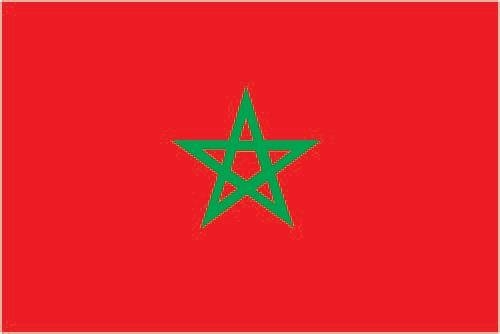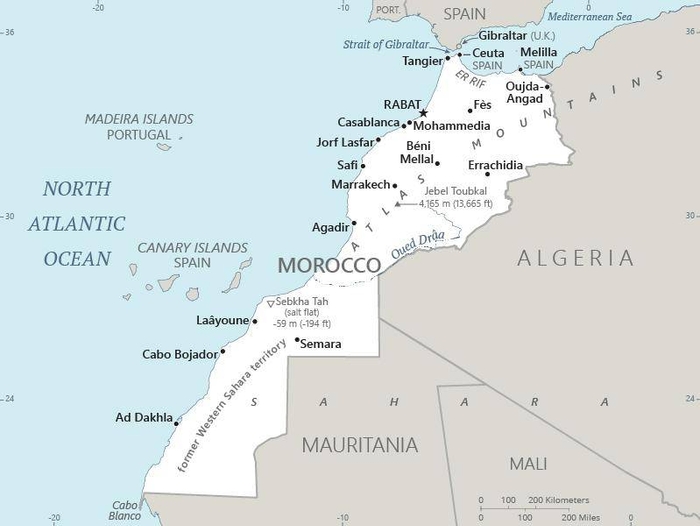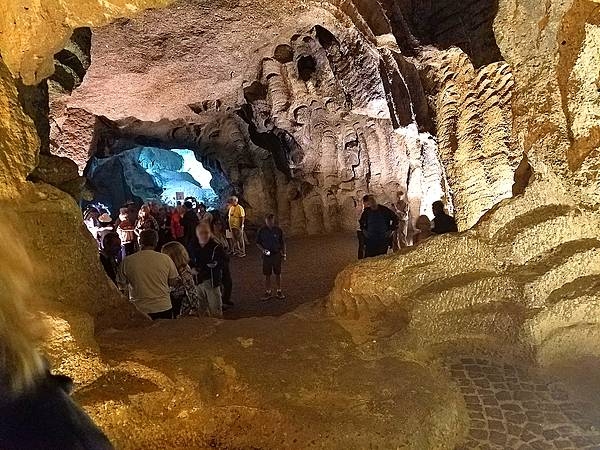211 Morocco

Red with a green pentacle (five-pointed, linear star) known as Sulayman’s (Solomon’s) seal in the center of the flag. Red and green are traditional colors in Arab flags, although the use of red is more commonly associated with the Arab states of the Persian Gulf. The pentacle represents the five pillars of Islam and signifies the association between God and the nation. Design dates to 1912.
Flag courtesy of the CIA World Factbook

Map courtesy of the CIA World Factbook

The interior of the Hercules Caves near Tangier. At high tide, Atlantic Ocean waters flood the caves, which are part natural and part man-made. The man-made section was used in the past by Berber people to cut stone wheels from the walls to make millstones, thus expanding the caves considerably. The lower right shows evidence of the millstone cutting.
Photo courtesy of the CIA World Factbook
Government
According to Britannica, Morocco is a constitutional monarchy with two legislative houses. According to the constitution promulgated in 2011, political power in Morocco is to be shared between the hereditary monarch and an elected bicameral parliament, consisting of the House of Councillors (Majlis al-Mustashārīn; upper chamber) and the House of Representatives (Majlis al-Nawāb; lower chamber). A prime minister heads the cabinet, which constitutes the executive.
Despite the existence of a constitution, a legislature, and a number of active political parties, however, the king continues to wield broad political authority, promulgating legislation, choosing the prime minister from the largest party in parliament, and approving government appointments. He holds absolute authority over religious affairs, the armed forces, and national security policy.
The overwhelming authority of the monarch in political life has been a subject of intense debate and criticism. Since the mid-1990s, political reforms to strengthen representative institutions, enhance the authority of the parliament and cabinet, increase political participation, and limit the king’s ability to manipulate political affairs have been enacted under pressure both from internal opposition groups and from groups outside the country. In July 2011, Moroccan voters approved a new constitution proposed by King Muḥammad VI. The new constitution expanded the powers of the parliament and the prime minister but left the king with broad authority over all branches of government. The constitution also featured a new section promoting cultural pluralism in Morocco and granted the Tamazight language recognition as an official language.
At the local level, Morocco is subdivided into multiple levels of government, all directly under the Ministry of the Interior. At the top are 16 regions, which are further divided into several dozen provinces and urban prefectures, each ruled by a governor appointed by the king. Beneath this second-order subdivision are rural qaḍawāt (districts) and municipalities, governed by chefs de cercle. The fourth level comprises rural communes and autonomous urban centres, governed respectively by qāʾids (caids) and pashas. Lower-order officials are appointed either by the Ministry of the Interior or by the governors. Each level has popularly elected bodies whose primary function is to help determine local matters and priorities, such as initiating development projects and deciding budget expenditures. At the end of the 1990s, government policy was moving toward allowing greater decision making at the local level.
In theory, the Qurʾān is still the source of law. It is, in effect, exercised by the qāḍīs (Muslim religious judges) and is limited to matters relating to the personal status of Muslims. Rabbinical justice applies to Jews. All other matters, whether they concern Muslims, Jews, or others, are in the hands of secular courts that apply a French-inspired legal code. The highest legal authority is the Supreme Court, which supervises a legal system consisting of courts of appeal, regional tribunals, magistrates’ courts, and, at the lowest level, courts of first instance. All judges receive appointments from the king and are supervised by the Ministry of Justice. The legal system, however, has not been immune to pressures for reform. Moroccan women, in particular, have sought reforms in the Mudawwanah, or code of personal status and family law, in an effort to change inequities in inheritance, divorce, and other matters that have traditionally favoured men. In 2004 parliament issued a new, more liberal, personal status code.
Directorate General of Civil Aviation (DGCA)
The Directorate General of Civil Aviation (DGCA) has the following duties:
- To ensure the coordination, control and evaluation of the ministry’s interventions in the air sector. It is responsible for basic infrastructure and air navigation facilities and for the general operation of the air sector, for which it establishes regulations and oversees their application.
- To ensure the control and coordination of airport activities, conducting international negotiations and ensuring the execution of international agreements in the air domain to which Morocco has adhered.
- To apply the guidelines of the Minister with regard to the supervision of the department over public establishments whose activity is related to the field of air transport.
Airspace
SkyVector – Google Maps – ADS-B Exchange
ICAO countries publish an Aeronautical Information Publication (AIP). This document is divided into three parts: General (GEN), En Route (ENR) and Aerodromes (AD). ENR 1.4 details the types of airspace classes they chose to adopt from classes A through G.
THE REORGANIZATION OF MOROCCAN AIRSPACE BY 2035
Drone Regulations
None found by the author.
However, should you, the reader, happen to stumble across something to the contrary, please email the author at FISHE5CA@erau.edu and you may be mentioned in the ACKNOWLEDGEMENTS section of this book by way of thanks for contributing to this free eBook!
Advanced Air Mobility (AAM) Regulations & Policies
None found by the author.
However, should you, the reader, happen to stumble across something to the contrary, please email the author at FISHE5CA@erau.edu and you may be mentioned in the ACKNOWLEDGEMENTS section of this book by way of thanks for contributing to this free eBook!
Advanced Air Mobility (AAM) News
2025
Video courtesy of Advanced Air Mobility Institute from the July 2025 Global AAM Forum.
2025
Video courtesy of Advanced Air Mobility Institute from the January 2025 Global AAM Forum. Complete session for Day 2 of this Forum is available on the Advanced Air Mobility Institute YouTube Channel
Short Essay Questions
Scenario-Based Question
You have been hired by a Drone Startup Company. Your boss has immediately assigned this job to you.
They need you to prepare a one-page memo detailing the legalities of using a drone to film in Tangier.
They need you to mention any national laws and local ordinances.
They specifically want to know what airspace (insert pictures) you will be operating in and whether or not you need an airspace authorization.
Does it matter whether or not you are a citizen of the country?
Lastly, there is a bonus for you if, as you scroll through this chapter, you find any typos or broken links!
Short Essay Questions
- What are the drone categories?
- How is registration addressed?
- How is remote ID addressed?
- What are the model aircraft rules?
- What are the commercial drone rules?
- Are there waivers or exemptions to the rules? If so, for what?
- Would you share a link to an interactive airspace map?
- How is BVLOS addressed?
- How can you fly drones at night?
- How can you fly drones over people?
- Where do you find drone NOTAMs?
- What are the rules for drone maintenance?
- What are the rules for an SMS program?
- What are some unique rules not mentioned above?
- What are the C-UAS rules?
- What are the AAM rules?

